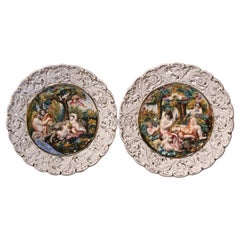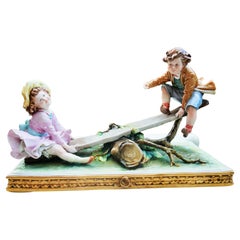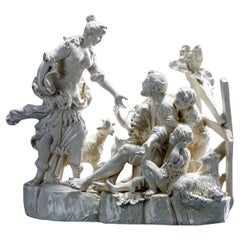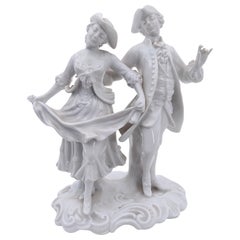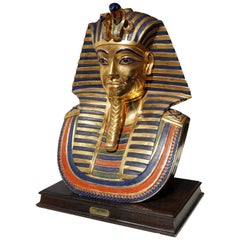Capodimonte Mounted Objects
If success is measured by lasting name recognition, Capodimonte porcelain would seem to be in the same league as such makers as Meissen, Sèvres and Wedgwood. Early examples of Capodimonte lamps — as well as the Italian manufacturer’s celebrated porcelain vases, figurines and sculptures — can be hard to come by, but the best later pieces possess the same over-the-top charm.
The Real Fabbrica (“royal factory”) di Capodimonte hasn’t actually produced porcelain since the early 19th century, when Charles’s son Ferdinand sold it. Although secondary manufacturers have built upon the aesthetic and kept the name alive, some connoisseurs of the royal product feel these pieces should be labeled “in the style of” Capodimonte.
The timeline of royal Capodimonte porcelain is decidedly brief. From beginning to end, its manufacture lasted approximately 75 years. King Charles VII of Naples, who founded the manufactory in 1743, began experimenting with porcelain around 1738, the year he married Maria Amalia of Saxony. No coincidence there. His new bride was the granddaughter of Augustus the Strong, Elector of Saxony and founder of Meissen, the first European hard-paste porcelain manufactory. Her dowry included 17 Meissen table services.
Struck by porcelain fever, Charles built a dedicated facility on top of a hill (capo di monte) overlooking Naples. He financed expeditions to search for the right clay. He hired chemists and artisans to experiment. His earliest successes were small white snuffboxes and vases, although efforts soon progressed to full sets of tableware, decorative objects and stylized figurines of peasants and theatrical personalities.
In 1759, Charles succeeded to the throne of Spain. He moved the manufactory with him — including 40 workers and 4 tons of clay — and continued operations in Madrid. Twelve years later, his son Ferdinand IV, who inherited the throne of Naples, built a new factory there that became known for distinctly rococo designs.
The Napoleonic wars interrupted production, and around 1807, oversight of the royal factories was transferred to a franchisee named Giovanni Poulard-Prad.
Beginning in the mid-18th century, porcelain made by Charles’s factory was stamped with a fleur-de-lis, usually in underglaze blue. Pieces from Ferdinand’s were stamped with a Neapolitan N topped by a crown. When secondary manufacturers began production, they retained this mark, in multiple variations. The value of these later 19th- and 20th-century pieces is determined by the quality, not the Capodimonte porcelain marks.
Find antique and vintage Capodimonte porcelain for sale on 1stDibs.
Late 20th Century Italian Capodimonte Mounted Objects
Majolica, Porcelain
1950s Italian Vintage Capodimonte Mounted Objects
Ceramic
1860s Italian Other Antique Capodimonte Mounted Objects
Ceramic
1960s Italian Mid-Century Modern Vintage Capodimonte Mounted Objects
Porcelain
Mid-20th Century Italian Mid-Century Modern Capodimonte Mounted Objects
Porcelain, Wood
19th Century Italian Neoclassical Revival Antique Capodimonte Mounted Objects
Porcelain
Late 20th Century Italian Renaissance Revival Capodimonte Mounted Objects
Porcelain, Mahogany
1920s Italian Baroque Revival Vintage Capodimonte Mounted Objects
Porcelain
Late 20th Century Italian Modern Capodimonte Mounted Objects
Porcelain, Lucite
Early 20th Century Italian Art Deco Capodimonte Mounted Objects
Porcelain
Late 19th Century Italian Classical Greek Antique Capodimonte Mounted Objects
Porcelain
Mid-20th Century Italian Mid-Century Modern Capodimonte Mounted Objects
Ceramic
Mid-20th Century Italian Mid-Century Modern Capodimonte Mounted Objects
Porcelain
1980s Italian Mid-Century Modern Vintage Capodimonte Mounted Objects
Porcelain
Mid-20th Century Italian Neoclassical Revival Capodimonte Mounted Objects
Porcelain
Capodimonte mounted objects for sale on 1stDibs.
- Is my Capodimonte real?1 Answer1stDibs ExpertAugust 29, 2024To know if your Capodimonte is real, look for its maker's mark. Beginning in the mid-18th century, porcelain made by the manufacturer founded by King Charles VII of Naples was stamped with a fleur-de-lis, usually in underglaze blue. Pieces produced under Ferdinand IV were stamped with a Neapolitan N topped by a crown. When secondary manufacturers began production, they retained this mark in multiple variations. By comparing the markings on your piece to images of those found on similar pieces shared on trusted online resources, you can begin to determine whether your piece is authentic. However, many convincing replicas exist, so you may wish to have a certified appraiser or knowledgeable antique dealer examine your piece and provide you with a professional opinion. Explore a diverse assortment of Capodimonte porcelain on 1stDibs.
- What is Capodimonte's style?1 Answer1stDibs ExpertFebruary 27, 2024Capodimonte's style is regal and opulent, though it has varied over the years. Early pieces from the celebrated Italian porcelain manufacturer often reflect Rococo design sensibilities, with organic motifs rendered in soft colors. As trends changed, so did the look of Capodimonte porcelain, which skewed Victorian, Edwardian and Art Deco over the years that followed. Capodiomonte has also looked beyond its native Italy for inspiration, producing porcelain ware that reflects Japanese and ancient Roman decorative techniques. Shop a wide range of Capdodimonte porcelain on 1stDibs.
- Is Capodimonte worth money?1 Answer1stDibs ExpertFebruary 1, 2024Yes, Capodimonte pieces may be worth money. Early examples of the Italian manufacturer's celebrated porcelain vases, figurines and sculptures can be hard to come by, but the best later pieces possess the same over-the-top charm and are sought by collectors. The value of a particular item depends on its style, age and condition, as well as supply and demand in the marketplace. To get a better estimate of the value of your piece, consult a certified appraiser or knowledgeable dealer. Explore a wide range of Capodimonte decorative objects on 1stDibs.
- 1stDibs ExpertOctober 24, 2024Yes, some Capodimonte ornaments are worth something. Capodimonte has produced luxury porcelain wares since the 18th century, and many of its antique pieces have significant value. Vintage and even some contemporary ornaments may also be valuable, depending on their style, age, type and condition. A certified appraiser or knowledgeable antique dealer can give you an estimated value for any ornaments that you own. Shop a collection of Capodimonte pieces on 1stDibs.
- 1stDibs ExpertMarch 13, 2024To identify rare Capodimonte marks, use trusted online resources as a guide. Generally, the oldest pieces produced by the Italian maker during the mid-18th century are the rarest. During this period, Capodimonte typically used only its original blue fleur-de-lis logo as a mark. On reputable websites, you can find images of this mark and others used by the porcelain manufacturer over the years. If you need assistance identifying a particular piece, enlist the help of a certified appraiser or knowledgeable antiques dealer. Explore a range of Capodimonte porcelain ware on 1stDibs.
- 1stDibs ExpertOctober 30, 2024Yes, Capodimonte porcelain may be worth something. Early examples of Capodimonte lamps, as well as the Italian manufacturer’s celebrated porcelain vases, figurines and sculptures, can be hard to come by, so they are highly sought after and can be worth a significant amount. For example, a gilded teapot produced by the Italian maker during the mid-18th century sold for more than $160,000 at auction in 2011. In addition to age and availability, the type, style and condition of Capodimonte pieces will determine their potential selling prices. A certified appraiser or experienced antique dealer can perform the valuation process and estimate how much any porcelain wares you own may be worth. On 1stDibs, find a variety of Capodimonte porcelain wares.
- 1stDibs ExpertNovember 20, 2024Yes, some vintage Capodimonte may be worth something. Although often higher for antique items at least a century old, selling prices for pieces produced by the Italian maker within the last 20 to 99 years can sometimes be in the hundreds or thousands of dollars. Generally, the type, style, age, condition and availability determine the value of a particular Capodimonte piece. A certified appraiser or experienced antique dealer can be of assistance if you wish to have any items in your collection evaluated. On 1stDibs, explore a range of vintage Capodimonte porcelain wares.
- 1stDibs ExpertApril 22, 2024What the Capodimonte mark looks like has changed over the years. From 1743 through 1771, variations of the fleur-de-lis were the most common markings. From 1830 to 1967, the Italian maker generally used a letter N or G positioned beneath a crown. From 1967 onward, pieces generally displayed an impressed IPA stamp and a back stamp with a crowned letter N, the IPA lettering and the brand name. You can consult trusted online resources to see images of Capodimonte stamps from various eras. Additionally, you may wish to work with an antiques dealer to verify the age and authenticity of your porcelain. Find a collection of Capodimonte pieces on 1stDibs.
